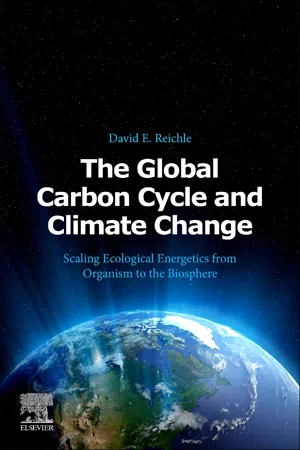Energy is essential for life on Earth. An organism with a positive energy balance is generally a successful organism in nature. Organisms and ecosystems have, consequently, evolved as highly efficient thermodynamic systems. Bioenergetics deals with the energy requirements and the processing of energy by organisms. The term is most often used in reference to animals, but also applies to plants. Plants have evolved the unique photosynthetic process, using sunlight to split water molecules and manufacture organic carbon molecules from atmospheric CO2, thus converting radiant energy into chemical energy to support their metabolic requirements. In animal systems bioenergetics encompasses the procurement of the chemical energy in food, the digestion of food, subsequent metabolism, and the eventual energy expenditures required for living and reproducing. Bioenergetics involves, therefore, many aspects of the organism's physiology, thermal relationships, and behavior, and becomes very complex and complicated to quantify. Bioenergetics has become a very sophisticated tool in animal husbandry, for it deals with the efficiency by which animal protein can be produced economically. By the 1960s, bioenergetics as applied to free-living animals had bifurcated into two fields of study, one approach emphasizing behavioral biology where the animal's activity patterns were studied in relation to its energy balance with its environment, and another physiological approach dealing with the metabolism of the free-living organism. In actuality both these approaches are necessary to understand the thermodynamics of organisms in nature (Reichle et al., 1975).
By the 1970s the growing field of ecology began to utilize bioenergetics to understand the functioning of entire ecosystems. Thus, the study of ecological, or ecosystem, energetics developed. Ecosystem energetics addresses the energy balance of the entire ecosystem and all its trophic levels. It consists of the ecosystem's metabolism—its primary productivity, trophic level exchanges,
turnover and decomposition of detritus, growth, and reproduction. Since biologically utilized energy is the energy stored in carbon molecules, ecosystem metabolism necessarily deals with the carbon balance of the entire ecosystem (Lindeman, 1942; Odum, 1957; Smalley, 1960; Teal, 1962; Macfadyen, 1964; Phillipson, 1966; Woodwell and Botkin, 1970; Reichle et al., 1973). Besides plant photosynthesis and trophic level energetics, understanding the carbon metabolism of the entire ecosystem, above and below ground, includes death and decomposition to complete the ecosystem's carbon balance (net ecosystem production) with the environment. This academically intriguing subject suddenly took on tremendous societal relevance beginning in the 1980s, with the growing concern over the combustion of fossil fuels and the resulting CO2 emissions to the atmosphere, leading to the greenhouse effect and global warming.
What did we know about the global cycle of carbon? And, when did we know it (Rich, 2018)? Ecosystem carbon balances for different types of ecosystems, when used with the geographic distribution of ecosystem types, or biomes, formed the basis for early global carbon balance calculations (Craig, 1957; Revelle and Suess, 1957; Bolin, 1970). As the modeling of ecosystem bioenergetics advanced, it became possible to construct dynamic global carbon models of the biosphere, which were functionally based and could, consequently, permit questions to be asked about the biosphere's response to changing atmospheric CO2 levels or rising temperatures or changing land use cover or feedback loops such as oxidation of Arctic tundra, glacial melting, ocean outgassing, etc (Trabalka, 1985; Trabalka and Reichle, 1986). These questions remain very pertinent and central to the debate today on the consequences of climate change.
This text begins with an introduction to ecological energetics in Chapter 1. Chapter 2 defines energy terms, introduces the physical laws of energy, and discusses how the basic principles of thermodynamics govern biological as well as physical systems. Chapter 3 is a primer on energy relationships between organisms and the environment. Chapter 4 covers the biological energy transformations of photosynthesis and energy conversion efficiencies. In Chapter 5 the energy processing by animals, their metabolism, and energy budgets are examined. Chapter 6 examines how species adapt thermally to their environments. Chapter 7 addresses the energy exchange between plants and animals, ecological energetics, food chains, and the trophic level concept. Then in Chapter 8, the complexities of energy flow in ecosystems are covered. Subsequently, Chapter 9 examines the concept of ecosystem productivity; and then in Chapter 10 the global carbon cycle and the biosphere are reviewed. Chapter 11 examines how the anthropogenic emissions of CO2 and land use change have altered the natural global carbon cycle and have influenced climate change. Ultimately, humankind will have policy decisions to make about fossil energy use to avoid the negative climatic consequences of having changed the biosphere's carbon cycle (Chapter 12).
Before continuing, I need to make several brief comments about references. Much of the ecological energetics and productivity data from the decades of the mid-1960s to the mid-1980s, particularly during the International Biological Program, are contained in the proceedings of international conferences, which are now nearly inaccessible to many. I have identified these publications and extracted pertinent information from these sources so that it can remain in the mainstream of scientific literature. Secondly, I have sought permission to reproduce select graphs and illustrations contained in benchmark publications under copyright by publishers of books and scientific journals, so that they are available to those without the privileges of access to these sources through institutional library IT agreements. And lastly, when possible, I have referenced key data whenever they were published in government-sponsored symposia and reports; and since they are in the public domain, I have provided their urls for convenient, direct IT access by the reader.
